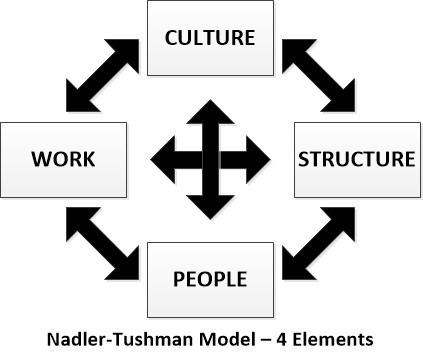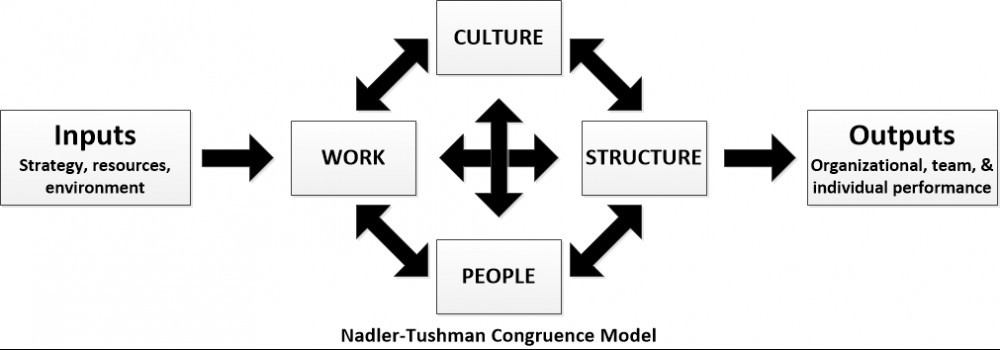The Nadler Tushman Congruence Model is a useful approach to identifying potential issues with project and change execution at the organization, team, and individual level. It can identify gap areas that need attention, and can help steer toward solutions that will work in the context.
Basics of the Nadler Tushman Congruence Model
The Nadler Tushman Congruence Model, also known as the Nadler Tushman Change Model, provides a structured way to identify incongruities within an organization that, if not confronted, can lead to project failure, organization under performance, and plain and simple falling short of goals and objectives.
The model consists of Inputs, four Interactive Elements, and Outputs as follows:
Inputs:
- Strategy – strategy at the organization, team, and/or individual level
- Resources – resources and capabilities at the requisite level
- Environment – external business environment surrounding the organization, team, or individual
Interactive elements:
- Culture – consider the leadership styles and organizational values
- Structure – org charts, systems and processes
- People – internal and external stakeholders effected by the tasks at hand
- Work – critical tasks that need to happen – what is done, and how it is processed
Outputs:
- Organizational performance – metrics in specific effected and related area(s)
- Team performance – similar metrics at the team level
- Individual performance – similar metrics at the individual level
The basis for the model is that change and the reaching of objectives is dependent upon getting the four elements working in tandem with each other – and if that cannot be accomplished, then changing the expectations.
Let’s look at those four elements in more detail.
The Four Elements of the Nadler Tushman Model
 Here’s a little more detail about each of the four elements of the model:
Here’s a little more detail about each of the four elements of the model:
- Culture – Culture is difficult to analyze, but if you look at leadership styles and organizational values and apply them to realistic scenarios, that can reveal what culture you have.
- Structure – This is about how the unit is organized, how decisions are made, and how information flows. This includes how people relate to one another, whether there is a rigid or loose hierarchy, and the degree of flexibility.
- People – Key considerations are level of education and experience, skills and knowledge, and career alignment with the organization. Level of compensation, rewards, and recognition come into the equation.
- Work – Consider the types of tasks, the flow of work, and the type of approaches that are needed to get the best results. What does it required to get the work done effectively? What are the challenges and rewards of the work?
With that basic information, some insights can begin to surface. The next step is to measure the ‘congruence’ between each of the four elements.
- Culture and Structure – Are these areas compatible? Does anything stick out that says that the way each of these is currently done is incompatible with the other – where culture and structure might clash?
- Culture and People – Is there a fit between the people and the culture? Will the people thrive in the culture, and will the culture help to unleash their potential? Is the way of working compatible with the culture?
- Culture and Work – Can you observe recent past work performance? What can you learn about how the culture supports not just the people, but the specific work itself? Does the culture mesh with the way work needs to get done?
- Structure and People – Is the organization’s structure well understood by the people? Do they embrace it, or in some ways reject or work around it? Does it support or stymie people with the given aptitudes, work ethic, and orientation?
- Structure and Work – Based on observations, does work tend to flow smoothly through the system or structure? Are there some specific hot spots that do not add value? Are there observed or potential blockages?
- People and Work – Is there a good match between the people, their skills and aptitudes, and the work to be done? Is there a compatibility in terms of interests, time spent, and effectiveness? Can people build careers here?
Just thinking about these things in a structured, ordered fashion can reveal potential issues that need to be addressed.
Inputs and Outputs of the Nadler Tushman Change Model
The starting point of the analysis is to gather some key inputs, including:
- Strategy – There is the overall strategy for the organization, the strategy for a team at either the departmental level or a project team, and strategy for activities at the individual employee/contributor level.
- Resources – This includes people, machinery and equipment, materials, partnerships, and other capability-providing resources.that are inputs to what the organization produces.
- Environment – This refers to the external business environment surrounding the organization, as would be described in a Political, Economic, Social, Technological, Legal, and Environmental (PESTLE) analysis.
These Inputs will be reviewed for how they might churn through the meat grinder of the organizations – its manifestation of the elements of Culture, Structure, People and Work.
The resulting Outputs include:
- Organizational performance – This includes key metrics such as units sold, quantity produced, cost per unit, and overall financial metrics related to the organization’s goals and objectives.
- Team performance – In addition to the pertinent metrics above for the organization, there will be appropriate department or project level metrics, such as on time delivery, desired quality, cost vs budget, and any other relevant measures.
- Individual performance – Performance of individuals will have some metrics as well. These will need to be evaluated in alignment with organizational strategy and objectives, similar to the Objectives and Key Results (OKR) process.
Strategic Implications of the Nadler Tushman Congruence Model
The interesting thing about the Nadler Tushman congruence Model is that it facilitates a holistic analysis of the four elements – Culture, Structure, People, and Work – for congruence of strategy and execution. Most frameworks focus either on strategy or execution, but this model supports evaluation of potential for execution success.
The model can point to the need for change. Adjustments may need to be made in any of the four elements in order to feel more comfortable with the prospects for success. This could take the form of:
- Making changes to any of the four factors within the organization
- Creating separate organizations with the appropriate design for Culture, Structure, People, and Work
- Partnering with other organizations who can help bring the four elements into congruence
The Nadler Tushman Model seems at once to be a strategic framework and an implementation framework.
Project Management Application of the Nadler Tushman Model
—————————————-
I recommend these PM templates (paid link):
—————————————-
The Nadler Tushman Congruence Model has its strengths and weaknesses. The model supports ‘thinking’ about the potential problems at hand, and can help point out areas that require attention. However, it does not solve these issues – potentially very challenging issues with culture, organizational structure, people, and work management. That is tough management work. The model, however, can effectively guide analysis to reveal shortcomings and point to areas that require work.
Specifically in project management, here are some areas where it can be particularly helpful:
- Change management – Projects sit at center of change. The model can support the project purpose, which is to implement a change.
- Portfolio management – The model can provide support to portfolio managers in weighing the costs and benefits of projects, and evaluating them against other projects.
- Risk management – The Nadler Tushman Framework provides a whole set of considerations related to project risks associated with the four elements, how they interact with each other, and their impacts on the project.
- Stakeholder management – The framework provides insights into how the project needs to support and interact with certain stakeholders, based on how those stakeholders fit with the four elements.
- Acquisition/purchasing management – The model can support outsourcing vs in sourcing decisions in a lot of areas, both in support of the projects and the operations.
The Nadler Tushman Congruence Model is a useful tool for project management and strategy.
The following are related resources (these are paid links):



